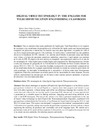Identificador persistente para citar o vincular este elemento:
https://accedacris.ulpgc.es/handle/10553/55622
| Campo DC | Valor | idioma |
|---|---|---|
| dc.contributor.author | Vera Cazorla, María Jesús | en_US |
| dc.date.accessioned | 2019-06-03T10:39:42Z | - |
| dc.date.available | 2019-06-03T10:39:42Z | - |
| dc.date.issued | 2016 | en_US |
| dc.identifier.issn | 2603-8560 | en_US |
| dc.identifier.other | WoS | - |
| dc.identifier.uri | https://accedacris.ulpgc.es/handle/10553/55622 | - |
| dc.description.abstract | Uno de nuestros retos como profesores de Inglés para Fines Específicos es ser capaces de involucrar a los estudiantes de postgrado en la utilización del inglés como una herramienta para compartir sus proyectos e interactuar, en nuestro caso con otros ingenieros, sin perder de vista el uso de la lengua extranjera para la vida cotidiana. Si motivación y autenticidad son dos palabras claves en la enseñanza de IFE, internet y sus muchas posibilidades se presenta como una fuente muy valiosa a la hora de encontrar materiales auténticos, atractivos y motivadores que emplear en el aula de IFE. El objetivo de este artículo es compartir una experiencia práctica en el uso de las tecnologías de vídeo digital para enseñar Inglés para Ingenieros de Telecomunicación, llevada a cabo con alumnos de postgrado de la Universidad de Las Palmas de Gran Canaria durante los cursos 2012-13 y 2013-14. Este curso fue diseñado en respuesta a las necesidades comunicativas de los estudiantes dentro de su propia especialidad, teniendo en cuenta las carencias particulares de cada estudiante, sin descuidar la enseñanza de la gramática y el léxico entre otras herramientas lingüísticas. Para ello, realizamos un estudio previo de las necesidades de estos alumnos. En este artículo, explicaremos las razones que nos llevaron a crear nuestros propios materiales, el proceso de selección y los resultados obtenidos. | en_US |
| dc.description.abstract | One of our challenges as teachers of English for Specific Purposes is to be able to involve post-graduate students in the use of English as a tool to share their projects and interact in our case with other engineers, without losing sight of the use of foreign language for everyday life. If motivation and authenticity are two key words in teaching ESP, internet and its many possibilities is presented as a valuable source to finding authentic, engaging and motivating materials to be used in the ESP classroom. The aim of this article is to share a practical experience in the use of digital video technology to teach English for Telecommunications Engineers, conducted with post-graduate students from the University of Las Palmas de Gran Canaria during the 2012-13 and 2013-14 school years. This course was designed in response to the students’ communicative needs within their own specialty, taking into account the particular requirements of each student, without neglecting the teaching of grammar and vocabulary and other language tools. We carried out a preliminary study of the needs of these students. In this article, we will explain the reasons that led us to create our own materials, the selection process and results. | en_US |
| dc.language | eng | en_US |
| dc.relation.ispartof | Cauce | en_US |
| dc.source | Cauce [ISSN 2603-8560], n. 39, p. 147-162 | en_US |
| dc.subject | 58 Pedagogía | en_US |
| dc.subject.other | IFE | en_US |
| dc.subject.other | Tecnologías de vídeo digital | en_US |
| dc.subject.other | Ingeniería de Telecomunicación | en_US |
| dc.subject.other | ESP | en_US |
| dc.subject.other | Digital Video Technologies | en_US |
| dc.subject.other | Telecommunication Engineering | en_US |
| dc.title | Digital video technology in the English for telecommunication engineering classroom | en_US |
| dc.type | info:eu-repo/semantics/article | en_US |
| dc.type | Article | en_US |
| dc.identifier.isi | 000415751300008 | - |
| dc.description.lastpage | 162 | en_US |
| dc.identifier.issue | 39 | - |
| dc.description.firstpage | 147 | en_US |
| dc.investigacion | Artes y Humanidades | en_US |
| dc.type2 | Artículo | en_US |
| dc.contributor.daisngid | 1651280 | - |
| dc.description.numberofpages | 16 | en_US |
| dc.utils.revision | Sí | en_US |
| dc.contributor.wosstandard | WOS:Vera-Cazorla, MJ | - |
| dc.date.coverdate | 2016 | en_US |
| dc.identifier.ulpgc | Sí | es |
| dc.description.esci | ESCI | |
| dc.description.dialnetimpact | 0,0 | |
| dc.description.dialnetq | Q3 | |
| dc.description.dialnetd | D8 | |
| item.grantfulltext | open | - |
| item.fulltext | Con texto completo | - |
| crisitem.author.dept | GIR Estudios sociolingüísticos y socioculturales | - |
| crisitem.author.dept | Departamento de Filología Moderna, Traducción e Interpretación | - |
| crisitem.author.orcid | 0000-0002-0210-030X | - |
| crisitem.author.parentorg | Departamento de Filología Moderna, Traducción e Interpretación | - |
| crisitem.author.fullName | Vera Cazorla, María Jesús | - |
| Colección: | Artículos | |
Los elementos en ULPGC accedaCRIS están protegidos por derechos de autor con todos los derechos reservados, a menos que se indique lo contrario.
